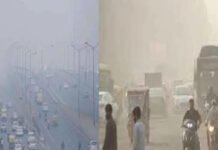The monsoon season continues to unleash its force across India, bringing heavy rainfall from the Himalayan hills to the vast plains. Widespread flooding has been reported in several states, claiming lives, disrupting transport, and displacing thousands. According to the India Meteorological Department (IMD), a series of heavy rainfall alerts have been issued for multiple regions over the coming days, signaling that the weather chaos is far from over.
Bihar Floods Leave 26 Dead, Thousands Stranded
Bihar remains one of the hardest-hit states, with 26 people confirmed dead due to flooding. Continuous downpours have inundated large swathes of Patna, Bhagalpur, Sitamarhi, and other districts, leaving roads and railway tracks submerged. Relief operations are underway, with government agencies and volunteers working to deliver food, medicine, and other essentials to affected families.
The IMD has warned of more heavy rain in East and West Champaran, Gopalganj, Siwan, Saran, Aurangabad, Arwal, Buxar, and Bhojpur on August 12, further heightening the risk of worsening flood conditions.
Uttarakhand Faces Torrential Rains and Rising Rivers
In Uttarakhand, the situation has escalated after torrential rains lashed Nainital district, severely affecting Ramnagar and surrounding areas. Waterfalls and streams in the hilly terrain have overflowed, while the plains grapple with severe waterlogging.
The IMD predicts heavy to very heavy rain across the state for the next seven days, likely to raise river levels and pose landslide threats. Residents in vulnerable areas have been advised to move to safer locations, while disaster response teams remain on high alert.
Himachal Pradesh: Landslides Add to Monsoon Misery
In Himachal Pradesh, two more lives were lost due to rain-triggered landslides, pushing the death toll higher as the monsoon season intensifies. The IMD has issued orange alerts for Kangra, Mandi, Sirmaur, Chamba, and Shimla from August 11 onwards.
Continuous rainfall is expected for the next seven days, raising the risk of further landslides, flash floods, and road blockages in mountainous regions. Authorities have urged residents and tourists to avoid unnecessary travel to high-risk zones.
Delhi-NCR: Thunderstorms and Cloudy Skies
The national capital began the day with a minimum temperature of 26°C, slightly above normal, and is expected to reach 35°C by afternoon. The IMD forecasts thunderstorms and light rain for the day, offering some respite from the heat.
While rainfall in Delhi has been scattered, cloudy skies are expected to dominate, with intermittent showers keeping humidity levels high.
Uttar Pradesh: Monsoon’s Generosity Brings Both Relief and Disaster
The monsoon has been exceptionally generous to Uttar Pradesh this year. Several districts have witnessed light to heavy rain, replenishing reservoirs and boosting crop conditions. However, flooding has created havoc in Shahjahanpur, Ballia, Banda, Farrukhabad, Prayagraj, and Varanasi.
From August 12 to 15, the IMD forecasts heavy rain in different regions of UP, which could worsen conditions in already waterlogged areas. Relief teams are actively engaged in delivering aid to marooned populations, with rescue boats and medical camps set up in critical zones.
East Central and Peninsular Central India Brace for Heavy Downpours
Between August 13 and 17, East Central India and adjoining Peninsular Central India are forecast to receive heavy rainfall. Specific alerts have been issued for Madhya Pradesh, Chhattisgarh, and Andhra Pradesh, particularly on August 14 and 15.
In Madhya Pradesh, light rain is expected on Tuesday, followed by a prolonged heavy rain spell. Chhattisgarh’s low-lying districts are also on flood watch, while Andhra Pradesh’s coastal regions may see intense downpours.
Rajasthan: Monsoon Revival Expected
Rajasthan has enjoyed good monsoon rains this season, though rainfall has slowed in recent days. The Raksha Bandhan holiday saw light showers in select districts, but the IMD now predicts a monsoon revival between August 12 and 17.
Light rain is expected in multiple districts, which could bring relief from the recent heat and help sustain agricultural needs.
Coastal Warnings for Fishermen
The IMD has issued marine advisories warning fishermen against venturing into:
Southwest and west-central Arabian Sea (August 12–13)
Sri Lanka coast, Gulf of Mannar, and south Tamil Nadu coast (August 12–16)
Strong winds and rough seas pose serious risks, and authorities emphasize strict compliance with these warnings to prevent maritime accidents.
Disaster Management and Relief Measures
With monsoon hazards affecting multiple states simultaneously, National Disaster Response Force (NDRF) teams, state disaster management units, and local authorities are coordinating large-scale relief operations.
Key measures include:
Evacuation of residents from low-lying areas.
Distribution of food, drinking water, and medical aid.
Repair of damaged roads and restoration of rail connectivity.
Deployment of rescue boats and emergency shelters.
Seven-Day Weather Outlook (August 11–17, 2025)
Bihar: Persistent heavy rain, high flood risk in northern districts.
Uttarakhand & Himachal Pradesh: Heavy to very heavy rain with landslide risk.
Uttar Pradesh: Intense rain spells; flooding possible in eastern and central districts.
Madhya Pradesh & Chhattisgarh: Heavy rain from mid-week; potential river swelling.
Andhra Pradesh: Heavy coastal showers on August 14–15.
Delhi-NCR: Cloudy with intermittent thunderstorms.
Rajasthan: Light rain revival; cooler temperatures expected.
Coastal Tamil Nadu & Sri Lanka vicinity: Rough seas, strong winds.
Conclusion: A Prolonged and Powerful Monsoon
As the monsoon season of 2025 intensifies, India faces a complex mix of agricultural gains and disaster challenges. While farmers welcome the rains for their crops, urban flooding, landslides, and rising river levels highlight the urgent need for preparedness and coordinated relief efforts.
The next seven days will be critical, especially for flood-prone and hilly regions. Authorities urge citizens to stay informed, follow safety advisories, and cooperate with rescue teams to minimize loss of life and property.
















